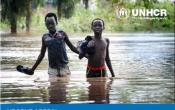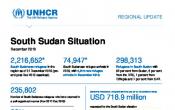South Sudan
Operation: South Sudan
Location
{"longitude":30,"latitude":7,"zoom_level":0,"iso_codes":"'SSD'"}
By clicking on the icons on the map, additional information is displayed.
The boundaries and names shown and the designations used on this map do not imply official endorsement or acceptance by the United Nations.
Key Figures
| 2019 year-end results | |
| 100% | of refugees had access to primary health care services. |
| 100% | of known survivors of sexual and gender-based violence (SGBV) received appropriate support. |
| 92.5% | of births were attended by skilled personnel, an increase from 88.5% in 2018. |
| 78.7% | of school-aged children were enrolled in primary education, an increase from 59% in 2018. |
| 18,300 | out of 36,750 targeted refugee households received core relief items. |
| 3,000 | out of 5,300 targeted household had sanitary facilities and latrines constructed. |
| 2020 planning figures | |
| 100% | of refugees with disabilities will receive service for their specific needs |
| 90% | of births will be attended by skilled personnel |
| 85% | of primary school-age refugee children will be enrolled in primary education |
| 83% | of households will have an individual latrine |
| 41% | of families will have access to sustainable energy |
| 3,750 | refugees will be trained on SGBV prevention and response |
| 525,000 | IDPs will have access to protection and assistance including core relief items, support to persons with specific needs and psychosocial support |
Latest Updates and Related Links
People of Concern
2%
Increase in
2019
2019
| 2019 | 2,354,090 |
| 2018 | 2,318,691 |
| 2017 | 2,202,145 |

[["Refugees",298313],["Asylum-seekers",3682],["IDPs",1665815],["Returned IDPs",276463],["Returned refugees",99817],["Others of concern",10000]]
Loading ...
South Sudan
< Back
2019
{"categories":[2015,2016,2017,2018,2019,2020],"budget":[413.880856341,275.66821274,171.67261918,155.2873228,152.18334368,197.10809986999996],"expenditure":[140.46294415,126.30817887,131.89496719,111.17078986,114.67014541999998,null]}
{"categories":[2015,2016,2017,2018,2019,2020],"p1":[185.32630537400001,167.85975155,130.87408023999998,120.07758228,107.75283929000001,133.57816672],"p2":[6.53999141,4.795793519999999,1.49549201,1.505682,1.1569643500000002,1.76180126],"p3":[null,null,null,null,12,35.486791350000004],"p4":[222.014559557,103.01266767,39.30304693,33.704058520000004,31.27354004,26.28134054]}
{"categories":[2015,2016,2017,2018,2019,2020],"p1":[96.29588561,87.87085463,105.18668788,85.12592905,89.26689522,null],"p2":[2.11256854,2.5470618700000003,0.83805353,1.00689489,0.5317120200000001,null],"p3":[null,null,null,null,2.56379952,null],"p4":[42.05449,35.890262369999995,25.870225780000002,25.03796592,22.307738660000002,null]}
Loading ...
CHOOSE A YEAR
- 2014
- 2015
- 2016
- 2017
- 2018
- 2019
- 2020
Operational context
Despite a complex and unpredictable operational and political environment in South Sudan, the Government maintained an open-door policy for refugees and asylum-seekers. UNHCR nonetheless continued to advise against returns to South Sudan, issuing an advisory in April 2019 that remained in place at the end of the year.Ongoing inter and intra-communal conflict continued to affect the protection environment and solutions for the 1.67 million people who were internally displaced.
The signing of the “Revitalized agreement on the resolution of the conflict in the Republic of South Sudan” (R-ARCSS) in September 2018, provided a general sense of stability and increased access for humanitarian workers in 2019 - except for a few areas in Central and Western Equatoria, where low intensity and localized armed conflict continued. The implementation of the R-ARCSS, however, proved challenging with the signatories disagreeing on several critical issues such as the demarcation of state boundaries.
Between August and November 2019, devastating floods worsened the living conditions of Sudanese refugees and host communities in Upper Nile and Jonglei States. Over 900,000 people, including some 150,000 refugees in greater Maban County, were affected.
Criminality remained the main threat to humanitarian agencies across the country.
At the High-Level Segment on Statelessness in October 2019, South Sudan declared five pledges committing to end statelessness by 2024 including accession to the two statelessness conventions by the end of 2020. The Government made four key pledges at the Global Refugee Forum, focusing on solutions, education, livelihoods and environment.
Population trends
In 2019, South Sudan hosted nearly 302,000 refugees and asylum-seekers, originating primarily from Sudan, the Democratic Republic of the Congo, Ethiopia and the Central African Republic. Some 8,600 refugees (prima facie) and more than 1,300 asylum-seekers arrived over the course of the year.Prospects for voluntary repatriation and resettlement remained extremely limited, with only 7 refugees departing for resettlement in 2019.
In 2019, about 100,000 refugees returned spontaneously to South Sudan from Uganda (42%), Sudan (30%) and Ethiopia (22%).
Some 1.67 million people were internally displaced at the end of the year, with the vast majority (some 87%) living in established communities and spontaneous settlements, and the remaining 13% residing inside one of the six UNMISS “protection of civilian” sites. The displacement situation included protracted and cyclical IDP movements due to concurrent conflicts, natural disasters and the limited capacity of the Government to respond to their needs.
Key achievements
- UNHCR’s advocacy efforts led to South Sudan’s accession to the Kampala Convention on IDPs in June 2019.
- With UNHCR’s support, the Government updated its national framework for return, reintegration and relocation of displaced persons in September 2019. UNHCR’s profiling showed some 40% of IDPs in urban areas were interested in returning to their homes.
- In September 2019, the Commission for Refugee Affairs approved a standard operating procedure for the screening and identification of combatants in refugee communities. A joint roadmap with UNHCR was drafted to assist in its implementation.
Unmet needs
With the operation 50% funded for 2019, the level of assistance and protection services was limited accordingly.- Unprecedented floods in greater Maban County devastated the infrastructure and livelihoods of 200,000 people. The critical need to rehabilitate shelters, WASH and education facilities remained unmet.
- UNHCR’s ability to support transitional or durable solutions for IDPs in South Sudan was heavily reduced. Although some 40% of IDPs in urban areas were interested in returning to their homes, support for returns was limited in the absence of information and services in the areas of return, and livelihood opportunities.
- Individual protection needs, family tracing and reunification, and housing, land, and property concerns remained unaddressed.
Operational Environment
By the end of 2018, there will be more than 300,000 refugees in South Sudan, with an annual increase of 20,000 people due to natural population growth and the anticipated influx of Sudanese refugees into Unity and Upper Nile States. The number of internally displaced persons (IDPs) is more than 1.8 million.In 2019, the operational environment in South Sudan is expected to remain complex, despite the signing of the Revitalized Agreement on the Resolution of the Conflict of the Republic of South Sudan (R-ARCSS) in September 2018. Implementation of the peace process is yet to be applied consistently, and the National Dialogue declared by the President has not convinced all parties to make genuine efforts towards peace. The success of the peace agreement will determine much of UNHCR’s response and operations in 2019.
As a result of clashes, insecurity and outbreaks of violence, humanitarian actors will continue to face challenges in their efforts to reach people in need. Limited access, due to inadequate infrastructure and security concerns, will further complicate the delivery of humanitarian assistance in many parts of the country. Due to the remoteness of some locations in South Sudan, there are logistical and security challenges hampering UNHCR’s access to field locations.
Despite these challenges, South Sudan maintains an open door policy for refugees and UNHCR delivers its protection mandate and assistance to people of concerns. In 2019, UNHCR will continue to place an importance on strengthening partnerships and ensuring coordination with relevant stakeholders, including Government, NGO and UN partners. UNHCR and its partners will work to maintain a synergy and necessary coordination within the Clusters and with Humanitarian Country Team (HCT) in accordance with the Refugee Coordination Model.
In 2019, support to the host community will remain one of UNHCR’s key priorities, and peaceful coexistence initiatives will be supported across the refugee locations.
Key Priorities
- Refugee response: UNHCR will continue to focus on livelihoods, youth programming and education; to prevent and respond to cases of SGBV and child protection; to support protection, self-reliance and pathways to solutions; as well as to strengthen social cohesion with host communities. Ongoing support will be provided to new refugee arrivals. The implementation of core protection activities will continue to ensure the identification and documentation of refugees. Continuous support to Refugee Eligibility Committee for the individual refugee status determination will also be provided.
- IDP response: UNHCR will continue to search for solutions for IDPs in the protection of civilians (POC) sites, including further efforts to decongest the POC sites, ensure the protection of the 89 per cent of IDPs living outside of POC sites, as well as support voluntary returns or relocations. UNHCR will also identify, and respond to the needs of the most vulnerable IDPs, work and ensure transparent dialogue with host communities on sharing resources, search for solutions and maintain protection leadership through engagement in coordination, as well as provide quality information and analysis of population movements. In addition, UNHCR will work with other humanitarian actors under protection cluster to find sustainable solutions for IDPs, as well as provide continuous support to the government to develop and implement a national legislation on IDPs to enhance protection and solutions for IDPs.
- Statelessness response: UNHCR will conduct training for the Directorate of Nationality, Passport and Immigration (DNPI) staff to assist them properly interpret and apply the Nationality Laws of South Sudan, as well as to increase understanding of the possible consequences of statelessness.


















